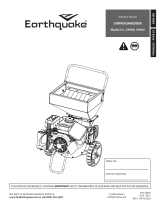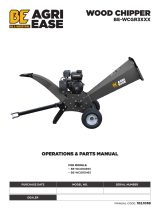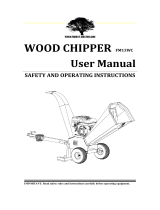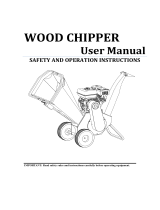
Page 5
1-800-345-6007
Safety Rules & Information
Read these safety rules and follow them closely. Failure to obey these rules could result in loss of control of unit,
severe personal injury or death to you, or bystanders, or damage to property or equipment.
This unit is capable of amputating hands and feet and throwing objects. The triangle in text signifies
important cautions or warnings which must be followed.
PREPARATION
1. Do not operate the equipment without wearing
adequate outer garments and safety goggles. Avoid
loose-fitting clothes and use protective footwear that will
improve footing on slippery surfaces.
TRAINING
1. Read the operating and service instructions carefully.
Be thoroughly familiar with the controls and the proper
use of the equipment. Know how to stop the unit and
disengage the control quickly.
2. Keep the area of operation clear of all persons,
particularly small children, and pets.
GENERAL OPERATION
1. Read, understand, and follow all instructions in the
manual and on the unit before starting.
2. Do not put hands or feet near rotating parts or under
the machine. Keep clear of the discharge opening at all
times.
3. Only allow responsible adults, who are familiar with the
instructions, to operate the unit (local regulations can
restrict operator age).
4. Be sure the area is clear of other people before operating.
Stop the unit if anyone enters the area.
5. Never direct discharge material toward anyone. Avoid
discharging material against a wall or obstruction.
Material may ricochet back toward the operator.
6. Operate the machine only in daylight or good artificial
light.
7. Do not operate the unit while under the influence of
alcohol or drugs.
8. Always wear eye and hearing protection when operating
this unit.
9. Keep in mind the operator is responsible for accidents
occurring to other people or property.
10. It is a violation of California Public Resource Code Section
4442 to use or operate the engine on or near any forest-
covered, brush-covered, or grass-covered land unless the
exhaust system is equipped with a spark arrester meeting
any applicable local or state laws. Other states or federal
areas may have similar laws.
11. Always operate the chipper/shredder outdoors, on a
firm, level, earthen or grassy surface where the unit will
be stable and stay in position. Never attempt to operate
the unit on a slope, or on a wet or slippery surface where
you could slip and fall toward the chipper cone or hopper
openings.
12. Never operate the chipper/shredder on asphalt, concrete,
or other hard surfaces as material being ejected out of
the discharge chute could ricochet, causing injury to you
or bystanders.
13. Always obey the size limitations for tree limbs and
branches stated in the Waste Materials Guide portion of
this manual.
14. Never leave the machine running unattended. Always
turn off the engine, wait for the rotor to come to a
complete stop, and disconnect the spark plug before
leaving the area. Always move the unit to a safe storage
area when not in use.
15. Always maintain secure footing and solid balance while
starting or operating the chipper/shredder. Never lean
directly over the machine.
16. Always stand to the side of the chipper cone when
feeding tree limbs and branches into the unit, as tree
limbs, branches, and harder woods may kick back while
being chipped.
17. Always keep hands out of the chipper cone and shredder
hopper when feeding materials. Never wrap fingers
tightly around branches as you are feeding them into the
unit, as a sudden inward surge could pull your hands and
arms into the unit.
18. Never allow material to build up in the discharge area
or shredding chamber, as this may cause new material
being fed into the machine to kickback with sufficient
force to injure you or other bystanders.
19. Never allow material to build up around the engine
during chipper/shredder operation. This could result in a
fire, or overheating of the engine.
20. Never attempt to reposition or move the chipper/
shredder unit while it is running. Doing so could cause
the machine to tip over, and reaching to steady the unit
could result in accidental insertion of your hands into the
chipper cone or shredder hopper areas.
21. Never continue to operate the machine if it starts
making unusual noise or vibration. Shut the engine off
immediately, allow the rotor to stop, disconnect the
spark plug wire and secure the wire away from the spark
plug. Inspect the unit for any signs of damage or foreign
material in the chipping or shredding areas. Remove
any solid material that may be preventing the unit from
operating properly.
22. Never attempt to clear clogs from the chipper cone,
shredder hopper or discharge chute while the unit is
running. Always shut the engine off, allow the rotor to
come to a complete stop, and remove the spark plug wire
from the spark plug before removing excess materials.
23. Never attempt to perform any maintenance, repairs,
or attachment of accessories while the unit is running.
Always shut the unit off, allow the rotor to come to a
complete stop, and remove the spark plug wire from the
spark plug before beginning these activities.
24. Always make sure that the shredding chamber, shredder
hopper, and chipper cone are empty before starting
the unit after it has been idle. Attempting to start the
unit with material in these areas could cause the engine
starting cord to stop suddenly, injuring your hand and
fingers, or toppling the unit over. Vibration is generally a
warning sign of trouble.
25. Before cleaning, repairing, or inspecting, shut off the
engine and make certain that all moving parts have

























